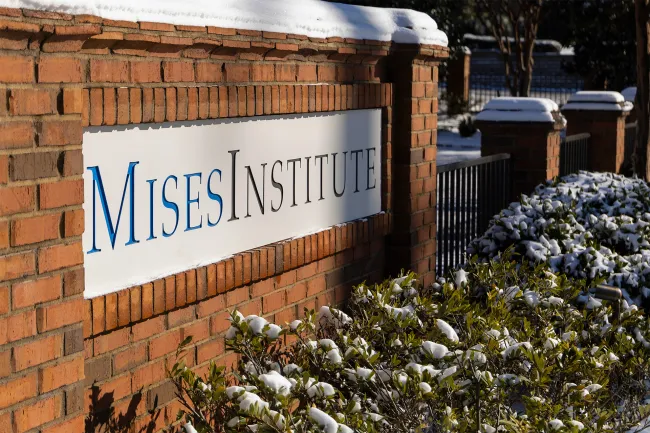Money-supply growth rose year over year in April, marking the ninth month of growth in a row. As of April, the money supply appears to be continuing into a period of solid monetary growth coming out of a period of historically large swings in monetary trends from early 2020 to mid-2024. Although some critics of Jerome Powell and the Fed have claimed that the Fed is implementing excessively tight monetary policy, the money supply has grown by more than $600 billion since mid-2023.
In April, year-over-year growth in the money supply was at 2.2 percent. That’s up from March’s year-over-year increase of 1.4 percent. April’s increase is also a big change from April 2024 when the year-over-year growth rate was negative 0.4 percent.

Following the big swings experienced during 2023 and 2024, money supply growth over the past nine months has settled into an upward trend with monthly growth, on average, of 1.8 percent. During that time, the total increase in the money supply has been 1.0 percent. Looking at month-to-month changes in the money supply, we also find a moderate upward trend. The money supply grew 0.6 percent from March to April. Over the past year, the money supply has increased, month over month during eight of the twelve months:

The money supply metric used here—the “true,” or Rothbard-Salerno, money supply measure (TMS)—is the metric developed by Murray Rothbard and Joseph Salerno, and is designed to provide a better measure of money supply fluctuations than M2. (The Mises Institute now offers regular updates on this metric and its growth.)
In recent months, M2 growth rates have followed a similar course to TMS growth rates, although M2 is growing faster than TMS. In fact, M2 is now at the highest level it’s ever been, including the inflationary surge of the covid panic. In April, the year-over-year M2 growth rate was 4.5 percent. That’s up from March’s growth rate of 3.9 percent. April’s growth rate was also up from April 2024’s rate of 1.0 percent. Month over month, M2 increased by 0.5 percent from March to April.
Although year-over-year and month-to-month growth rates may generally moderate, money-supply totals remain far above what they were before 2020 and the covid panic. From 2020 to 2022, the Federal Reserve’s easy-money policies resulted in approximately 6.4 trillion dollars being added to the economy. This was done to help to finance the federal government’s enormous deficits driven by runaway covid stimulus programs.

Since 2009, the TMS money supply is now up by nearly 194 percent. (M2 has grown by nearly 156 percent in that period.) Out of the current money supply of $19.4 trillion, nearly 26 percent of that has been created since January 2020. Since 2009, in the wake of the global financial crisis, more than $12 trillion of the current money supply has been created. In other words, nearly two-thirds of the total existing money supply have been created just in the past thirteen years.
As a result money-supply is now well above the former trend that was in place before 2020. For example, just to get to back to the money-creation trend that existed in 2019 before the “great covid inflation,” total money supply would need to fall by at least three trillion dollars.
In spite of this continued monetary inflation, some critics of the Fed—who are often pro-Trump activists (or Trump himself)—insist that the Federal Reserve is too hawkish.
Trump for example, has repeatedly pressed for lower interest rates even though, as economist Brendan Brown has recently noted, the real, inflation-adjusted policy interest rate is under one percent. Brown concludes we could hardly judge this “as restrictive or indicative of monetary disinflation.” Core CPI price inflation continues to be elevated and remains above the Fed’s arbitrary two-percent target.
Rather than allow the market to work—which would almost surely result in rising interest rates and monetary tightening—the Fed has continued to intervene in the economy to maintain a target policy rate of 4.5 percent. At the same time, the Fed has repeatedly lowered its targets for reducing its balance sheet. At its March meeting, the Fed’s FOMC, which had previously pledged to reduce its treasury holdings by as much as $25 billion per month, reduced the cap to only $5 billion per month. The FOMC has also capped its mortgage asset monthly drawdown to only $35 billion. Not surprisingly, money supply growth accelerated in April.

This isn’t to say there there are no signs of monetary deflation or price deflation on the horizon. Although the Fed’s posture is clearly in favor of monetary inflation, a sizable slowing of demand, coupled with a growing wave of delinquencies could lead to deflation. For example, year over year growth in commercial real estate loans has fallen to almost zero in recent months. And, delinquencies in auto loans, student loans, and credit card loans are near the highest levels reported since the Great Depression. If deflation appears, this reversal, Brown notes,
could be due to materialization of endemic fragilities [in the economy] coupled with the negative psychological impacts of trade war. As of now, though, asset price inflation remains robust it seems, even though there are some doubts related to weakness in some residential real estate markets, in the fine art market, and some pull back in the previous bubble conditions in private equity.

For now, the money supply trend remains solidly upward. Moreover, in any context longer than just a few months, the money supply has experienced tremendous growth. This has led to immense asset-price growth in homes, and in services such as auto insurance. Any true monetary deflation would be a boon for first-time homebuyers and consumers who face a historic lack of affordability in homeownership in recent years.


